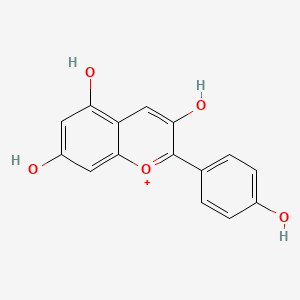| MeSH term | MeSH ID | Detail |
|---|---|---|
| Cystitis | D003556 | 23 associated lipids |
| Parkinsonian Disorders | D020734 | 20 associated lipids |
Pelargonidin
Pelargonidin is a lipid of Polyketides (PK) class. The involved functions are known as Uptake, Intestinal Absorption, glucose uptake, Process and Metabolic Inhibition. Pelargonidin often locates in Serosal, Mucous Membrane, brush border membrane, Membrane and Cell surface. The associated genes with Pelargonidin are SLC5A1 gene, SLC2A2 gene, Homologous Gene, F3 gene and CRSP3 gene. The related experimental models are Knock-out.
Cross Reference
Introduction
To understand associated biological information of Pelargonidin, we collected biological information of abnormalities, associated pathways, cellular/molecular locations, biological functions, related genes/proteins, lipids and common seen animal/experimental models with organized paragraphs from literatures.
What diseases are associated with Pelargonidin?
There are no associated biomedical information in the current reference collection.
Possible diseases from mapped MeSH terms on references
We collected disease MeSH terms mapped to the references associated with Pelargonidin
PubChem Associated disorders and diseases
What pathways are associated with Pelargonidin
There are no associated biomedical information in the current reference collection.
PubChem Biomolecular Interactions and Pathways
Link to PubChem Biomolecular Interactions and PathwaysWhat cellular locations are associated with Pelargonidin?
Visualization in cellular structure
Associated locations are in red color. Not associated locations are in black.
Related references are published most in these journals:
| Location | Cross reference | Weighted score | Related literatures |
|---|
What functions are associated with Pelargonidin?
Related references are published most in these journals:
| Function | Cross reference | Weighted score | Related literatures |
|---|
What lipids are associated with Pelargonidin?
There are no associated biomedical information in the current reference collection.
What genes are associated with Pelargonidin?
Related references are published most in these journals:
| Gene | Cross reference | Weighted score | Related literatures |
|---|
What common seen animal models are associated with Pelargonidin?
Knock-out
Knock-out are used in the study 'MATE2 mediates vacuolar sequestration of flavonoid glycosides and glycoside malonates in Medicago truncatula.' (Zhao J et al., 2011).
Related references are published most in these journals:
| Model | Cross reference | Weighted score | Related literatures |
|---|
NCBI Entrez Crosslinks
All references with Pelargonidin
Download all related citations| Authors | Title | Published | Journal | PubMed Link |
|---|---|---|---|---|
| Fossen T et al. | Dimeric anthocyanins from strawberry (Fragaria ananassa) consisting of pelargonidin 3-glucoside covalently linked to four flavan-3-ols. | 2004 | Phytochemistry | pmid:15231416 |
| Xie DY et al. | Molecular and biochemical analysis of two cDNA clones encoding dihydroflavonol-4-reductase from Medicago truncatula. | 2004 | Plant Physiol. | pmid:14976232 |
| Wang L et al. | Purification and cloning of a Chinese red radish peroxidase that metabolise pelargonidin and forms a gene family in Brassicaceae. | 2004 | Gene | pmid:15588587 |
| Ando T et al. | Delphinidin accumulation is associated with abnormal flower development in petunias. | 2004 | Phytochemistry | pmid:15587706 |
| Matsufuji H and Shibamoto T | Inhibition of malonaldehyde formation in oxidized calf thymus DNA with synthetic and natural antioxidants. | 2004 | J. Agric. Food Chem. | pmid:15373421 |
| Sugita O et al. | A new method of measuring the antioxidant activity of polyphenols using cumene hydroperoxide. | 2004 | Ann. Clin. Biochem. | pmid:14713390 |
| Chaovanalikit A et al. | Characterization and quantification of anthocyanins and polyphenolics in bluehHoneysuckle (Lonicera caerulea L.). | 2004 | J. Agric. Food Chem. | pmid:14969540 |
| Gonçalves B et al. | Effect of ripeness and postharvest storage on the phenolic profiles of Cherries (Prunus avium L.). | 2004 | J. Agric. Food Chem. | pmid:14759143 |
| Xie DY et al. | Anthocyanidin reductases from Medicago truncatula and Arabidopsis thaliana. | 2004 | Arch. Biochem. Biophys. | pmid:14725861 |
| Kaneko T et al. | Inhibition of linoleic acid hydroperoxide-induced toxicity in cultured human fibroblasts by anthocyanidins. | 2003 | Biosci. Biotechnol. Biochem. | pmid:12843669 |
| Matsufuji H et al. | Identification of reaction products of acylated anthocyanins from red radish with peroxyl radicals. | 2003 | J. Agric. Food Chem. | pmid:12720408 |
| Behrens A et al. | MALDI-TOF mass spectrometry and PSD fragmentation as means for the analysis of condensed tannins in plant leaves and needles. | 2003 | Phytochemistry | pmid:12591272 |
| Stobiecki M et al. | Monitoring changes in anthocyanin and steroid alkaloid glycoside content in lines of transgenic potato plants using liquid chromatography/mass spectrometry. | 2003 | Phytochemistry | pmid:12590123 |
| Kähkönen MP and Heinonen M | Antioxidant activity of anthocyanins and their aglycons. | 2003 | J. Agric. Food Chem. | pmid:12537433 |
| Tatsuzawa F et al. | 6-Hydroxypelargonidin glycosides in the orange-red flowers of Alstroemeria. | 2003 | Phytochemistry | pmid:12648544 |
| Safari MR and Sheikh N | Effects of flavonoids on the susceptibility of low-density lipoprotein to oxidative modification. | 2003 | Prostaglandins Leukot. Essent. Fatty Acids | pmid:12878454 |
| Seeram NP et al. | Inhibition of proliferation of human cancer cells and cyclooxygenase enzymes by anthocyanidins and catechins. | 2003 | Nutr Cancer | pmid:12925310 |
| Fukui Y et al. | A rationale for the shift in colour towards blue in transgenic carnation flowers expressing the flavonoid 3',5'-hydroxylase gene. | 2003 | Phytochemistry | pmid:12657292 |
| Wang H et al. | Characterization of anthocyanins in grape juices by ion trap liquid chromatography-mass spectrometry. | 2003 | J. Agric. Food Chem. | pmid:12643639 |
| Wang SY et al. | Elevated carbon dioxide increases contents of antioxidant compounds in field-grown strawberries. | 2003 | J. Agric. Food Chem. | pmid:12848504 |
